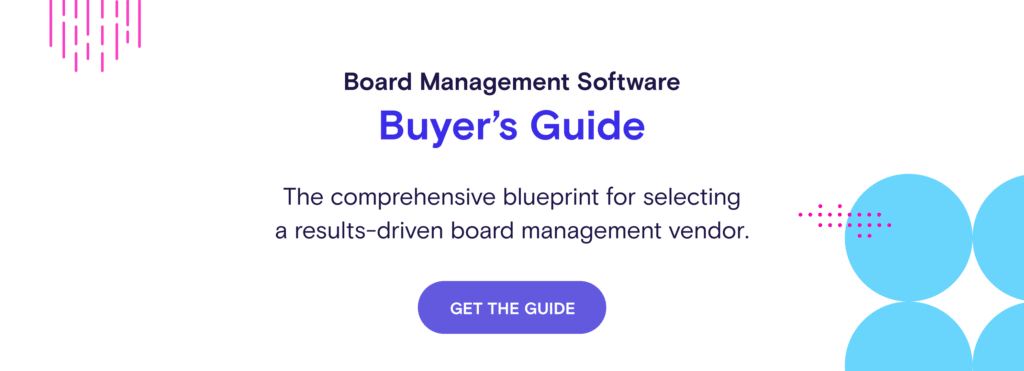
Longtime board effectiveness researcher Matt Fullbrook wants a new definition of board governance that's logical, but provocatively new.
If someone asked you to define “corporate governance” in a simple sentence, could you do it? If that on-the-spot question makes you break out in stress hives, you’re not alone.
During a recent OnBoard webinar, 70% of attendees said they were not up to the challenge of defining governance that concisely. It’s a definition that even governance consultant Matt Fullbrook has been wrestling with for some time.
“I started asking CEOs and board chairs: ‘What, to you, is corporate governance?’ A lot of people had never really thought of it, but many would come back with something along the lines of ‘corporate governance is governing corporations.’ Which of course isn’t helpful. But it illustrates that we’re using this word, governance, without actually having a confident idea of what we mean,” Matt says.
The founder of Fullbrook Board Effectiveness and Ground-Up Governance, Matt is the Executive In Residence at the University of Toronto’s Rotman School of Management and a longtime board effectiveness researcher.
Recently, he joined us for our ATLAS Leadership Webinar Series to explain why he’s proposing a new definition of governance that’s fundamentally logical yet provocatively new. Here, we’ll cover:
- Why Good Governance Equals Good Decision-Making
- Decision-Making Barriers and How to Overcome Them
- How Boardroom Layout Impacts Decision-Making
- The Key to Productive Virtual Meetings
Why Good Governance Equals Good Decision-Making
Many common definitions of corporate governance are filled with jargon, associated with stuffiness, and not well-understood by the common layperson.
Matt saw this as a distinct problem for people who must interact with governance at the top levels of their organizations. He set out to simplify matters and disrupt the status quo.
A New Definition of Corporate Governance
What follows is Matt’s new-and-improved definition of not just corporate governance, but good corporate governance:
Corporate governance is the way that decisions get made in an incorporated entity. Good governance means actively creating conditions that are likely to result in effective decisions.
Note that while it’s quite simple and to-the-point, the above definition does not include any of the corporate buzzwords that we often intrinsically link with governance.
Why Corporate Standards are Separate from Governance
Words like boards, executives, policies, processes, bylaws, compliance, disclosure, and executive compensation are notably absent from Matt’s definition of governance. That’s by design.
“All these things we think of as being the substance of corporate governance, but I think the substance is making decisions,” Matt says. “We have all these puzzle pieces: board and executives and external-interested parties and money and all kinds of different stuff that we could put together in different ways to lead us to decisions, either good or bad. All those elements are still important, but corporate governance happens even without them.”
While elements like your board, your commitment to diversity, and other factors can help you reach good decisions, Matt says we shouldn’t think of them as governance checkboxes that we need to mark off. Instead, we should focus on enabling good decision-making.
This sentiment is echoed by a recent McKinsey piece, which focuses on the direct correlation between quality decision-making and board effectiveness. In fact, the article says organizations that make fast and good decisions outperform their peers by two times.
“Governance isn’t compliance or strategic oversight. It’s not about shareholder performance. It’s not about hiring or finding a CEO, ESG, or even the effectiveness of your board. It’s about creating conditions that are likely to result in an effective decision,” Matt says.
Even though abandoning the traditional nuts and bolts of compliance-oriented governance is scary, it’s somehow freeing in its simplicity.
Decision-Making Barriers and How to Overcome Them
Matt chose to separate his definition of good governance from traditional corporate standards. That’s because facilitating good decision-making is something that can be addressed on its own.
“One change in the vibe of a group of people can take a decision-making capacity from 100% to 0%. And no amount of compliance is going to address this issue,” Matt says.
Common Obstacles to Good Decisions
So what prevents good decisions from taking root? While Matt’s definition of good governance is simple, the act of making good decisions is not simple for many reasons.
Here are 4 of the most common barriers, which Matt refers to as the “villains” that prevent good decision-making:
- Confirmation bias: We tend to embrace information that supports what we already believe, and reject information that goes against what we already believe.
- Narrow framing: Sometimes we enter the boardroom with a predetermined binary mindset on an item that is up for decision or vote. Instead of framing decisions as yes/no, it’s important to hear from all participants and consider all options.
- Short-term emotion: Embarrassment can prevent us from speaking up and expressing ourselves in the boardroom. Instead of second-guessing if the time is right, it’s important to have a voice and ask questions.
- Overconfidence: We’re inclined to be overconfident in our own expertise or the expertise of others. In reality, Matt says the more overconfident you become, the less likely your predictions are going to be correct.
Many of the above factors are the product of subconscious or deeply rooted behaviors. But that does not mean it’s impossible to foster a good decision-making environment in the boardroom.
Best Practices to Unlock Good Decision-Making
Conditions that help good decision-making thrive include opening the door to multiple opinions and options.
For example:
- To combat the overconfidence of experts in the room, try to encourage them to ask questions instead of making predictions and making statements.
- To broaden narrow framing and reduce confirmation bias, foster inclusion — the superpower that activates diversity.
These subtle shifts create the conditions that help everybody thrive.
“The challenge in a boardroom is that there’s no such thing as conditions that will optimize the inclusion of every person simultaneously. That’s why we must think about who is in the room, what their styles are, and how we can best hear them,” Matt says.
While certain laws and rules should always be followed, keeping a flexible approach to conversations is what will increase the chance that every voice is activated and the best decisions are reached. That is why mixing up the status quo is so crucial.
How Boardroom Layout Impacts Decision-Making
One place to start experimenting is in the physical setup of your boardroom itself. A participant in over 300 boardrooms, Matt has seen similar layouts repeatedly — think circle, oval, rectangle, and horseshoe.
Those traditional layouts work well to facilitate:
- Consuming information
- Receiving a presentation
- Making eye contact with attendees
- Hearing everybody
- Seeing who’s voting and who’s not
Yet, none of the above factors are effective decision-making conditions.
“We wouldn’t say that the job of a board is to consume information, to look each other in the eye, to hear each other clearly, and to vote. That’s certainly not sufficient,” Matt says. “There are so many different things that we deploy and try out to facilitate good decision-making and effective teamwork in every other part of the organization except the boardroom.”
Many companies are quick to innovate for enhanced engagement elsewhere in the company, but don’t change the traditional boardroom layout. After all, the decisions the board makes are perhaps more consequential than the decisions made anywhere else.
The Case for Modular Boardrooms
The best boardroom setup Matt witnessed happened completely by chance. An organization was holding its annual board retreat in person during the tail end of the COVID-19 pandemic and wanted to socially distance. The venue ended up placing them in schoolhouse-style, wheeled desk-chair combos.
At the start of the meeting, each desk was spaced 6 feet apart from the others. But as the board retreat moved through different phases, the board members instinctively changed the layout of the room. They moved from clustering in pairs or small groups to a circular layout — and back again — in an effort to optimize the layout of the room for each discussion they were having.
“There is something really brilliant about the layout of a room that can be modular to suit the types of conversations or decisions that we need to make, because we know not every decision requires the same conditions in our boardrooms,” Matt says.
For example, we shouldn’t use the same approach to approve the last meeting’s minutes as we do to approve a new line of business. Those activities benefit from very different conditions. The more that we make the conditions the same between those two very different decisions, the more concerned we should be that we’re not experimenting enough.
“We shouldn’t be sitting here and saying to ourselves, ‘You know what we’re so great at? Doing the same thing over and over again, and having the same people in a room for a long time,’” Matt says.
Even if your current boardroom set up is working “fine,”why not mix it up and see what happens?
The Key to Productive Virtual Meetings
With many of today’s board meetings going virtual, physical layout does not always matter. Yet there are still steps that will foster optimal engagement in the quest to make good decisions.
In fact, while Matt says in-person conversations can have a magical quality that’s valuable for making important decisions, virtual meetings encourage inclusion.
“No matter who you are, no matter how short or tall you are, no matter what your position is in the organization, everyone gets the same piece of real estate on the screen. And we all have access to the same prompts and tools. So there is an equalizing factor,” Matt says.
Every person can attend virtual meetings, regardless of most physical limitations. The only barrier is finding time on your calendar.
Take Engagement Beyond Finger-Pointing
More than 80% of all board directors planned to meet virtually in some form or fashion over the next 12 months, according to the OnBoard 2022 Board Effectiveness Survey. When asked how they define board effectiveness, survey respondents had one loud and clear answer: engaged board members.
Engaging members means more than going around the circle or having the chair ask specific board members to respond on command.
“How many people have you met in your life who are able to spontaneously generate brilliant strategic insights when you just point a finger at them? In my life, I would argue that number is zero. And the conditions in a boardroom that we put people under are basically expecting them to do that,” Matt says.
Instead of putting people on the spot, the key to engaging people is to stay really curious about each person’s conditions. Ask questions. If someone presents the beginning of an interesting idea, ask them to repeat themselves and go deeper. Engaged members includes everyone taking an interest in what the other is saying, and respecting the ideas and voices board members share.
Take the Onus off the Board Member
The burden of initiating participation shouldn’t always be everyone’s personal responsibility. Engagement is a group effort, Matt says.
“One of the great mistakes that I see made frequently in boardrooms with respect to engagement is we put all of the onus on the individuals to engage themselves,” Matt says.
Instead, a board chair should recognize different participation styles and make an effort to draw each board member out. For example, if you recruited a board member who was visually impaired, you would not bring them into the boardroom and expect them to just figure it out. You would ask them questions and try to understand how they’d like to participate.
Likewise, in virtual meetings, if someone is less inclined to speak up or cut off a more talkative member, it’s helpful for the board director or other observant members to notice. They can then pass the mic in a tactful way, and create an opportunity for the less-talkative members to share their ideas and opinions.
Go Forth and Disrupt the Status Quo
If your board’s norm consists of a stale meeting structure and board members who struggle to speak up, it’s probably time to consider how you can create a better decision-making environment.
Even if things are going well, it’s worth considering how you could change things. You never know what you could discover.
“The status quo is fine. I just don’t buy this thing that we hear all the time, ‘Well, it’s working OK, so why not continue to do it?’” Matt says. “We don’t build our boardrooms deliberately, and I believe we should.”
Continuity is not the ideal state for a successful board. Yet if your board can create a culture, system, and set of conditions where you can be continuously curious, that is the type of continuity to achieve.
Where do you start? Try something 1% different at your next meeting and see what happens.
To hear Matt’s complete thoughts on good governance, watch the full ATLAS webinar.
Ready to incorporate board management tools that make engagement and informed decision-making easier than ever? Request a free OnBoard trial today.
Want to fuel your startup for success? Get started with a free trial of OnBoard.
About The Author

- Josh Palmer
- Josh Palmer serves as OnBoard's Head of Content. An experienced content creator, his previous roles have spanned numerous industries including B2C and B2B home improvement, healthcare, and software-as-a-service (SaaS). An Indianapolis native and graduate of Indiana University, Palmer currently resides in Fishers, Ind.
Latest entries
 Board Management SoftwareApril 24, 2024How to Develop a Crisis Response Plan (Step-by-Step)
Board Management SoftwareApril 24, 2024How to Develop a Crisis Response Plan (Step-by-Step) Board Management SoftwareApril 15, 2024Q&A: What is the Board of Directors’ Role in Compliance?
Board Management SoftwareApril 15, 2024Q&A: What is the Board of Directors’ Role in Compliance? Board Management SoftwareApril 11, 2024Regulatory Compliance Training: 5 Best Programs
Board Management SoftwareApril 11, 2024Regulatory Compliance Training: 5 Best Programs Board Management SoftwareMarch 27, 20245 Steps in the Initial Public Offering Process
Board Management SoftwareMarch 27, 20245 Steps in the Initial Public Offering Process



